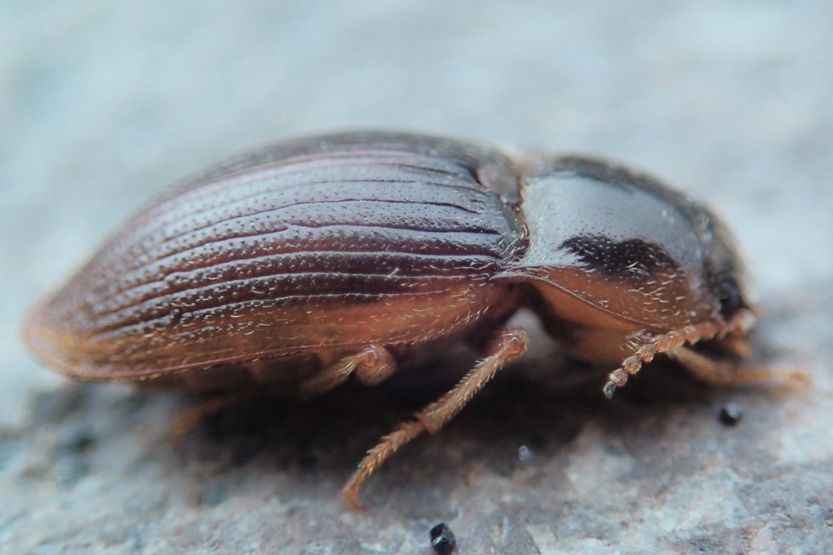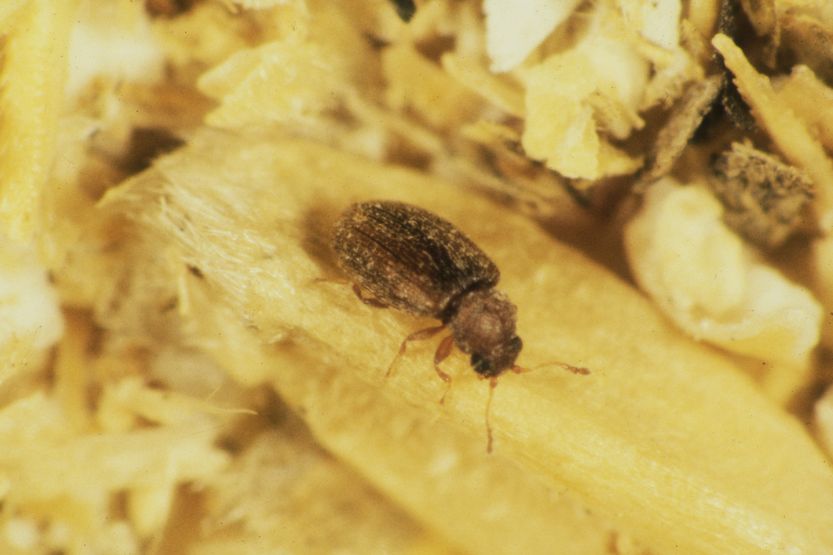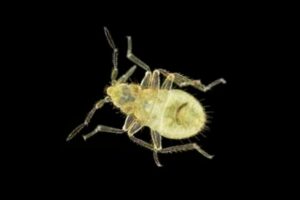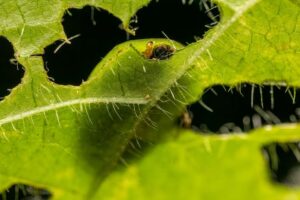Biscuit beetles are one of the typical pantry pests that infest homes, flour mills, bakeries, drugstores, and even museums. While these picky feeders are solitary, they can also form groups with other species. So, what is the best way to get rid of biscuit beetles?
Throw away any infected food and adequately clean the area of any food remnants. Then, look under your house’s eaves or loft for old nests, as these are frequent hiding places for biscuit beetles. Apply flex 10-10 and fill all cracks and crevices with “Pyrid” aerosol. If this doesn’t solve the issue, contact a professional pest controller to inspect the area and eliminate those pests.
Read on to learn more about biscuit beetles and how to get rid of them and prevent them from entering your home!
How to Get Rid of Biscuit Beetles Permanently?

First, you should act as soon as possible once you spot these tiny brown insects inside your home. The method of treatment is quite similar to that used for other pests:
1. Dispose of Contaminated Food
You must first dispose of any contaminated food, thoroughly clean the affected area, and vacuum it well while paying attention to every crack, crevice, and corner. When done, seal the contents of the vacuum before you throw it away.
2. Identify the Source of Infestation
This step will require a thorough inspection, the destruction of all infested items in a domestic setting, and a deep cleaning of the affected area to eliminate all food remnants, eggs, larvae, and adult beetles.
Next, check your home’s loft or eaves for old nests, as biscuit beetles love hiding in such places.
Biscuit beetles can live between 13 to 65 days as adults under ideal conditions, and they can survive for around 70 days at 82.4°F and 200 days at 62.6°F. Infested items will have both live and dead adults present.
3. Clean Your Pantry Before Starting Any Treatment
Before starting the treatment, you must set up your pantry and food storage areas. You’ll need a vacuum and cleaning supplies for this. We recommend that you first remove everything from your cabinets and throw it away.
This also saves you time because otherwise, you would have to inspect every item in your pantry for signs of an infestation.
Vacuum the area after removing all the products, paying close attention to the corners. Clean and disinfect all shelves thoroughly. Once you finish cleaning and emptying your food storage area, you can start the treatment.
4. Fill Cracks and Crevices with “Pyrid”
Pyrid spray is a ready-to-use insecticide aerosol that works well as a crack and crevice treatment inside pantries and a flushing agent. You must treat such areas first to prevent drugstore beetles from hiding their eggs.
To use Pyrid, take the white applicator out of the can and swap it out for the red applicator with a straw tip.
Shake the can and quickly spray in short bursts, often at a rate of roughly one second of spray per foot, along the length of the cracks and crevices of your pantry shelving.
This powerful spray will drive pests away from these locations. After flushing any pest out, it will give an instant knockdown rather than a lasting effect.
5. Apply Flex 10-10
Use Flex 10-10 after applying Pyrid to the affected area. The pyrethroid pesticide Flex 10-10 kills drugstore beetles for up to 30 days after application and has a lengthy residual impact.
Apply Flex 10-10 to the pantry shelves by diluting it first in a pump sprayer. Mix it with water and shake it off well before applying it.
You can use the Flex 10-10 as a low-pressure fan spray along the back and side corners of the pantry shelves.
Remember that once you finish, you should stay away from the affected area until it fully dries.
6. Have a Qualified Pest Controller Do a Residual Spray Treatment
Fortunately, a broad and deeply ingrained infestation in a typical household kitchen is rare and often goes away when you cut off the larval food source. But, if the solutions above do not work, contact a pest controller.
A qualified pest controller will provide a thorough residual spray treatment if the issue continues.
7. Fumigation
Fumigation of the infested area may be an alternative in business buildings and should be done by a professional fumigation provider. It is a highly effective treatment for infestations that will eliminate the lifecycle of the pests while protecting your items so you may keep using them.
How to Prevent Biscuit Beetles Infestation
Because the larvae like dark, warm, quiet areas, it is important to look carefully for the food source when you see adult beetles scavenging. Infestations usually start from rarely used dry foods like flour or spices. So, you will want to remove unused or outdated food to eliminate any potential infestation.
You will see adult beetles near fireplaces and vents without a visible food source. These most likely came from bird or wasp nests in the attic. Also, watch out for bread in fireplaces that birds have dropped down the chimney.
Remember that the key here for effective eradication is proper cleanliness.
Everything You Need to Know About Biscuit Beetles

Size and Appearance
Adult biscuit beetles have a cylindrical body that ranges in color from light brown to red-brown and are 1/10–1/7 inch (2.25–3.5 mm) in length.
Their wings feature unique grooves covered in tiny, silky, thick hairs. Biscuit beetles look like humpback whales because you can’t see their head from above.
They also share similar looks with cigarette beetles as they are closely related. Biscuit beetles, however, lack noticeable grooves on their wing covers and have round, oval bodies.
Moreover, biscuit beetles have loose, three-segmented club antennae. The larvae of the biscuit beetle have a 3/16-inch (4.76 mm) long, creamy white, C-shaped body.
Biscuit Beetles’ Life Cycle
The female lays her pearly white eggs, and once the eggs have hatched, they spend about 4-5 months as larvae. They consume the food source during this time and may spread, going from one place to another. They can easily pierce packaging.
Before developing into an adult, the larvae spend the next 12 to 18 days in the pupal stage. The duration of this phase of the life cycle is not long. Adult biscuit beetles do not eat. Instead, they roam for around 3 to 4 weeks, laying new eggs.
Not only do biscuit beetles lay their eggs on different food sources, but they can also move far from the initial location. Due to their attraction to light, you can also spot them in places such as work surfaces or window frames.
Biscuit beetles will typically have four broods every year.
Can Biscuit Beetles Go Away on Their Own?
Biscuit beetles do not disappear on their own unless they mature into adults. As they prepare to pupate, larvae dig burrows through the substrate of their food supply.
They remain within those layers during their whole pupal stage before emerging as adults. The larvae will only go away when there is not enough food available.
How to Identify Biscuit Beetles
Before starting the treatment, it is essential to know what you are dealing with and ensure it is a biscuit beetle rather than something else. Otherwise, misidentification can cost you both time and money. So, keep the following in mind to correctly identify biscuit beetles:
- Know the difference between cigarette and biscuit beetles, as they are closely related. The antennae of the biscuit beetles have a distinctive three-segmented structure, whereas the cigarette beetle’s antennae are serrated.
- Biscuit beetles have a brownish-red color and a spherical, cylindrical shape. They usually have tiny hairs on their bodies between 0.07 to 0.13 inches long.
- The larvae of adult biscuit beetles look like little white grubs when they lay eggs. Moreover, the larvae are pretty tiny, and it’s unlikely that you’ll be able to see them with the naked eye.
Biscuit Beetles’ Hiding Spots
Once you have correctly identified biscuit beetles, carry out an inspection to find where they are hiding and what things they are infesting:
- Start the inspection process by looking around the areas where you keep your food supplies. Most biscuit beetle adults will break out of their cocoons where the larvae have been feeding.
- If you have adult biscuit beetles in your cupboard, then you probably have some cereal, spice, flour, cookie, grain, bean, or other things they are actively eating.
- If you have pets, check the cupboards, shelves, cabinets, garages, and places where pet food is kept.
- Check open food packages too. Even if you cannot see the adult beetles, they may have already set their eggs in place.
Are Biscuit Beetles Harmful?
Not Harmful to Humans and Animals
Biscuit beetles are not harmful to humans and animals. It is fine to touch them. However, the larvae are still considered pantry pests.
They infect dry food and can seriously harm items like leather shoes and artwork.
That said, biscuit beetles do not bite or sting people and animals. This beetle has little interest in humans or other animals and does not suck their blood.
They are considered herbivores, which means they consume plants mainly. Biscuit beetles are not predators. They do not like meat.
Do They Carry Disease?
No known disease has been linked to or transmitted by biscuit beetles. Because beetles are not considered parasites, neither humans nor pets are home to them.
However, they also have a propensity to trash food and other things. Almost all types of dry foods, candies, and plants are alluring to biscuit beetles.
They also like leather, glue, paper, and wool, among other non-food items.
Adult beetles find nighttime lighting to be fascinating. However, a study found that UV lights are more attractive to them than blue LED lights.
Infests a Wide Range of Foods
They will infest a wide range of foods, including cereal products, powdered soup, milk powder, etc., despite consuming all types of biscuits, including those that belong to your dogs.
However, they will also survive on dangerous things such as strychnine, belladonna, and aconite, which is why they get the name drugstore beetles.
Flour, biscuits, cake mixes, cereals, spices, and soup powders interest them the most. They can also cut through lead and tin foil as well as bookshelves.
When the eggs hatch, the newly born larvae will chew through most forms of packaging materials to feed on the contents inside. The female beetle will lay her eggs among foods favorable for larval growth.
Because adult beetles do not feed, the larvae inflict damage, which is how infestations in commercial food storage locations can easily spread quickly.
Again, how to get rid of biscuit beetles permanently? To get rid of biscuit beetles, use water and dish soap, vacuum them, set up beetle traps, or use insecticidal soap.
What Are the Tiny Grey Bugs Near Window?
How to Keep Biscuit Beetles Away from House?

Even after you get rid of every biscuit beetle in the bedroom and other areas, they could return and re-infest. So, how can you prevent them from coming again?
Here are some practical tips on how to keep biscuit beetles at bay:
- Never buy improperly sealed or packaged food.
- Avoid buying big amounts of grains, pet food, and other dry foods, especially during the summer when biscuit beetles are most active.
- Don’t combine fresh dry food supplies with expired ones. Put them in airtight metal, glass, or plastic containers as an alternative.
- Make sure to regularly vacuum and clean storage rooms, and no food residue is left on the premises.
- You should routinely inspect your bookshelves and pay extra attention to the titles you don’t often pick up because biscuit beetles also consume paper.
- Keep your leather bags, jackets, and shoes in your closet when not in use.
- Seal any potential access sites, such as broken window screens and small cracks in the walls, as adult biscuit beetles are excellent flyers.
- Properly stock your pantry with food. Replace the foods you have to throw out once your cupboard is fully clean.
- Don’t bring in used books or furniture without thoroughly inspecting them.
- Drugstore beetles eat food, but they also eat organic materials like paper, leather, and hair. So, make sure to properly inspect any furniture or books before taking them into your home. This could protect you against biscuit beetles and other pests like bedbugs.
Where Do Carpet Beetles Come From?
How to Get Rid of Biscuit Beetles Naturally
Despite their small size and rapid reproduction, biscuit beetles are not that difficult to manage. Insecticides can be helpful, but you should use them as a last resort. So, the following are some natural ways to eliminate biscuit beetles:
1. Deal with the Heavily Infested Food
Seal heavily infested food products in a plastic bag and then toss them away.
If you only have a small number of infected items, you can heat them in a pan at 120°F (48.8°C) for 16–24 hours or at 190°F (87.8°C) for at least an hour.
Alternatively, store the infected items in a freezer for at least two weeks at 36°F (2.2°C) or for at least one week at 25°F (-3.8°C).
2. Consider Using a Biscuit Beetle Trap
Click here to view it on Amazon.
Consider using a biscuit beetle trap, such as Pro-Pest Pantry Moth Traps. These traps can’t kill or repel the larvae, but they will capture the males and end their life cycle. You should place them close to the food source of the biscuit beetles.
3. Use Bay Leaves or Essential Oils
Use bay leaves or essential oils, such as peppermint oil, which can be an effective pest repellent. Peppermint oil is quite effective against many pests, including biscuit beetles.
The best way to use it is to soak cotton balls in the essential oil and place them in the back of your pantry. Remember to change the cotton balls every three days or so.
4. Make a Peppermint Oil Spray
You may also make a spray by combining two cups of water with 10 to 20 drops of peppermint oil and use it to clean your kitchen and pantry every few days.
5. Combine Dish Soap and Rubbing Alcohol
You can also make your spray using dish soap and rubbing alcohol. Spray down cupboards and pantries after vigorously shaking the bottle. The dish soap coats the insects, and alcohol dehydrates them and eventually kills them.
Conclusion – How to Get Rid of Biscuit Beetles
Biscuit beetles are considered pests all around the world. And, just like any other pest, they can inflict damage and infest many food items, so once you spot these brown insects within your home, you should take action immediately.
Before cleaning and vacuuming the afflicted area, you must throw away any contaminated food.
Next, look around your home for old bird nests, as biscuit beetles love hiding there. Use “Pyrid” spray and Flex 10-10 to fill all cracks and crevices.
This should help a long way in eradicating biscuit beetles, but, If it still doesn’t prove effective, get a professional pest controller to examine and treat the affected area.
Remember that prevention is better than cure. So, before storing the food in your pantry, ensure all the groceries you buy are in good condition and maintain your home’s cleanliness!
Read next:






